How to Take Minutes for a Meeting [2025 Comprehensive Guide]
- What Are Meeting Minutes?
- How to Take Meeting Minutes Step-by-Step
- Simple Tips to Improve Your Minute-Taking Skills
- 3 Best Tools to Take Accurate Meeting Minutes with AI
What Are Meeting Minutes?
Before learning how to take meeting minutes, it’s important to understand what they are. Meeting minutes are simply a written record of what was discussed, decided, and assigned during a session. They don’t need to include every single word said; just the key points. The goal is to make sure everyone has a clear summary of what was agreed on and what needs to be done next.
Key Elements of Meeting Minutes:
- Date, time, and participants
- Agenda items discussed
- Key decisions made
- Assigned tasks and responsible parties
- Follow-up actions or next discussion schedule
How to Take Meeting Minutes Step-by-Step
Now that you know what meeting minutes are, it is time for you to explore the steps on how to take meeting minutes. Taking accurate meeting minutes doesn’t require special skills, but it does require focus, organization, and some preparation. Here’s a simple step-by-step process:
1st Step: Prepare Before the Meeting
- Go through the agenda and understand the meeting’s objectives.
- Set up a template for taking minutes (or prepare an AI transcription tool). At a minimum, your template should include:
- Details of the MeetingSession: Date, time, location, participants, and absentees.
- Agenda items: Each topic to be discussed.
- Key points/decisions: Major discussions and agreements.
- Action items: Task, responsible person, and deadline.
- Notes/remarks: Optional space for additional observations or clarifications
You can create this in a Word document, Excel sheet, Google Doc, or use a dedicated tool like RecCloud, Trint, or Otter.ai that auto-formats the transcript into sections.
- Check who will attend and gather any necessary materials (pen, notebooks, paper, highlighters, etc.)
2nd Step: Stay Focused During the Session
- Write down the main points, decisions, and action items; don’t try to capture every word.
- Note who made each decision or suggestion.
- If allowed, use an AI tool (like Trint or RecCloud) to record and transcribe the meeting in real time.
3rd Step: Review and Finalize After the Output
- Check your notes for clarity, accuracy, and neutrality.
- Organize them with bullet points and headings so they’re easy to read.
- If required, share the final version with all participants and save it in a shared drive or project platform.
Here’s a guide on what to include and what to avoid in professional meeting minutes:
| Include in Meeting Minutes | Avoid Including in Meeting Minutes |
| Date, time, and meeting title | Personal opinions or interpretations |
| List of attendees and absentees | Word-for-word transcripts of discussions |
| Agenda items discussed | Informal chat or jokes |
| Key decisions made | Emotional reactions or tone |
| Action items and who’s responsible | Unconfirmed assumptions or speculation |
| Deadlines and follow-up dates | Sensitive or confidential details not relevant to action items |
| Motions and voting outcomes | Grammar corrections or filler words |
Simple Tips to Improve Your Minute-Taking Skills
There you have it! That’s a simple and easy guide on how to take minutes of your meeting sessions. Now that you know how to create them, here are some simple tips to improve your minutes. These tips will help you enhance your minute-taking skills. So, without further ado, explore the tips on how to take effective meeting minutes below.
1. Use a Template: Set up a simple layout with sections for the date, participants, agenda, key decisions, action items, and deadlines. This helps you stay organized and ensures nothing important is missed.
2. Focus on Outcomes: Write down the main decisions and action items instead of trying to capture everything said. This makes it easier for readers to see what was agreed on and what needs follow-up.
3. Stay Neutral: Stick to the facts and avoid adding personal opinions or assumptions that took place in the meeting. Neutral minutes are more reliable and easier to refer back to later.
4. Highlight Actions Clearly: Make sure every task shows who is responsible and the deadline. Clear action items help avoid confusion and keep the team accountable.
3 Best Tools to Take Accurate Meeting Minutes with AI
Now, those are the simple guides and tips on how to take meeting minutes. You might find taking meeting minutes a bit challenging, especially when discussions move quickly or multiple people talk at once. Therefore, this post recommends using these three AI-powered tools that can help you capture your meetings and automatically create accurate minutes, allowing you to focus fully on the discussion. So, explore them and see how they can make taking meeting minutes easier!
1. RecCloud – Best for Quick, Browser-based Minute Taking
Use case: Ideal for teams that need quick, AI-generated meeting minutes right after discussions.
The first tool that can help you take meeting minutes is RecCloud. This one supports a Free AI Speech to Text feature that allows you to convert live or recorded meeting sessions into meeting minutes format. It precisely transcribes meetings and accurately labels them with speakers and timestamps. Aside from that, it also automatically creates meeting minutes with topic, time, location, summary, discussion points, and action items; all are well-written and organized!
Key Features:
- Allows you to record a meeting session and convert it into written minutes after.
- Enables you to translate generated minutes into various languages.
- Lets you copy and paste the generated meeting minutes or export them as a Word file.
- Infused with an AI chatbot that lets you ask questions related to the minutes of the meeting.
Pros:
- Easy to use with an intuitive interface.
- Quick generation.
- Offers accurate output.
- Generates complete minutes information: time, location, summary, and more.
- Allows you to tweak the generated minutes through the tool’s AI chatbot.
Cons:
- A paid upgrade is required for the full experience.
Here’s how you can use it:
- Visit the RecCloud’s Free AI Speech to Text website on your browser. Then, upload the recorded meeting you want to create minutes from.
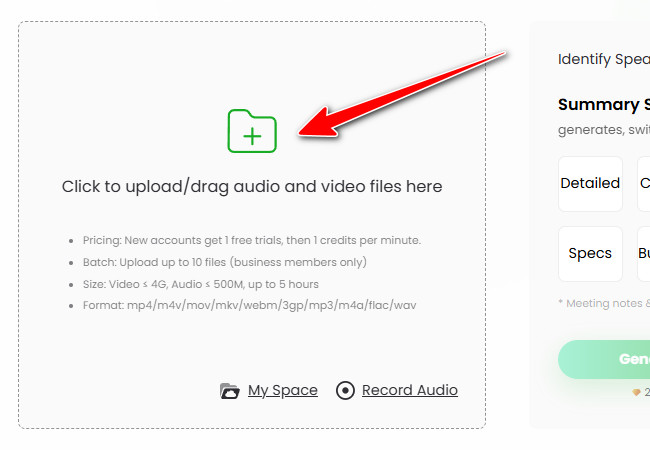
- Then, switch on “Identify Speakers”, select “Minutes” from “Summary Styles”, and click “Generate”. After that, wait for the tool to finish processing.
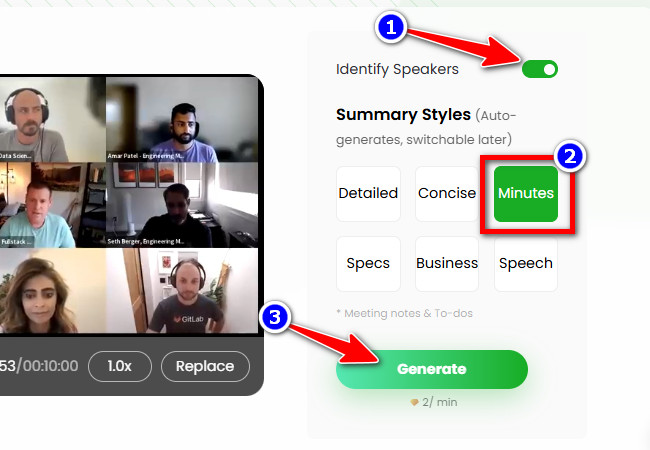
- Once done, you will see the generated meeting minutes in the right section of the tool with the topic, time, location, summary, action items, and discussion points.
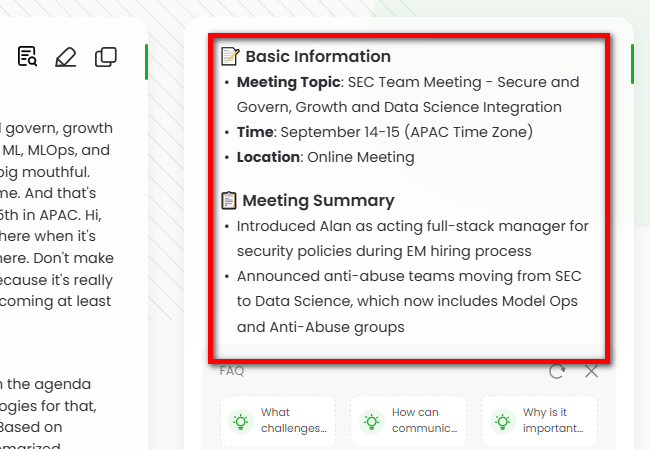
- Once satisfied with the output, click the “Export” button, select “Summary” (which is the generated minutes), and click “OK”. That’s it! Those are the steps you can use as a guide on how to take minutes for a meeting using this tool!
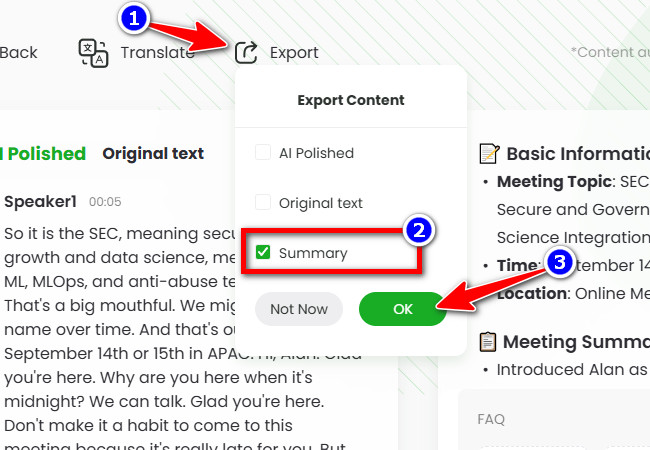
2. Trint – Best for Enterprise-level Accuracy and Editing
Use case: Best for professionals who require highly accurate, collaborative editing of formal meeting records.
Aside from the first tool, you can also take meeting minutes using Trint. This is an AI-powered transcription tool that helps turn meeting recordings into clear, searchable text within minutes. You can upload your audio or video, and Trint automatically transcribes it so you can highlight key points, tag speakers, and easily identify important discussions. It’s a handy tool for creating accurate minutes since you can review, edit, and share the transcript with your team.
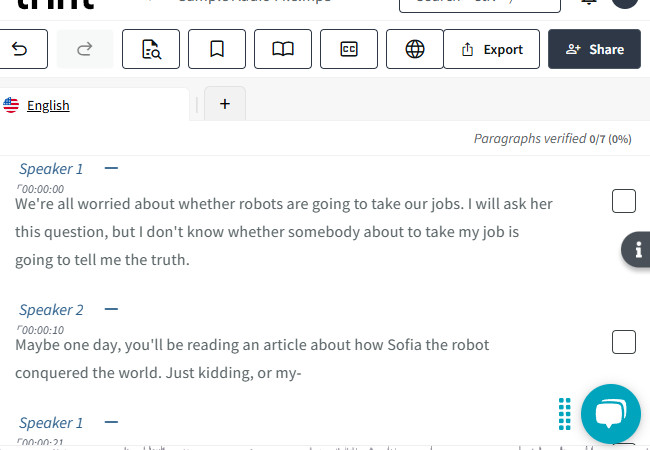
Key Features:
- Real-time collaboration for editing and reviewing transcripts or minutes.
- Supports many languages for transcription.
- Keeps your files safe in the cloud with team access control.
- Allows you to download transcripts in text, Word, or subtitle format.
Pros:
- Provides accurate minutes.
- Speeds up the process of turning meeting recordings into notes.
- Makes it easy to share and work on transcripts with others.
Cons:
- Pricing may be high for casual users.
- Might mishear technical terms or strong accents sometimes.
3. Otter – Best for Real-time Collaboration and Team Sync
Use case: Perfect for teams that want real-time meeting transcription and instant access to shared notes.
The last tool recommendation from this post is Otter. Like RecCloud and Trint, this is also an AI-powered assistant that can take meeting minutes. It records your discussions (in person or online), transcribes the conversation in real time, and generates editable text along with a summary of key decisions and action items. You simply start or upload the recording, and the tool produces a transcript you can highlight, edit, and share, making it a convenient way to turn spoken discussions into structured meeting minutes.
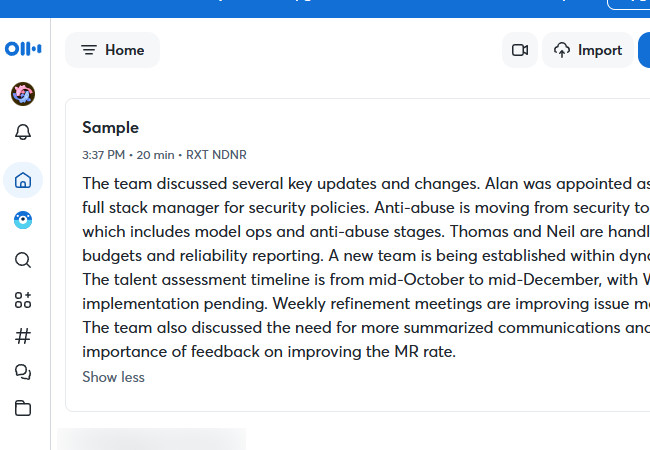
Key Features:
- Allows you to record and transcribe meetings or take minutes in real time.
- Automatically summarizes key points, tasks, and decisions.
- Syncs with Zoom, Google Meet, and Microsoft Teams.
- Allows team members to highlight and comment on transcripts.
Pros:
- Makes note-taking effortless with AI summaries.
- Helps teams stay aligned with searchable and shareable notes.
- Works across multiple platforms for easy access.
Cons:
- The free plan has limited transcription minutes.
- May struggle with overlapping voices or background noise.
- Some advanced features are locked behind paid plans.
| Tool | Summary & Action Item Generation | Speaker Identification | Real-Time Transcription | AI Meeting Minutes Accuracy | Pricing | Overall Rating & Insights |
| RecCloud | ✅ Yes (auto summary included) | ✅ Yes | ✅ Yes | ⭐⭐⭐⭐⭐ (Excellent) | Free / $4/month | Very Good – Best free option for quick, browser-based meeting notes. |
| Trint | ✅ Yes | ✅ Yes | ✅ Yes | ⭐⭐⭐⭐☆ (Very Good) | Starts at $48 | Excellent – Most accurate and professional-grade meeting minute generator. |
| Otter.ai | ✅ Yes (smart notes & tasks) | ✅ Yes | ✅ Yes | ⭐⭐⭐⭐☆ (Very Good) | Free / $16.99 Pro | Very Good – Great for real-time collaboration and live meeting summaries. |
Conclusion
There you have it! That’s the comprehensive guide on how to take meeting minutes, along with tips to create a great one. With these, you can now document and easily review all the important information discussed in your sessions. Now, if you find taking accurate minutes during meetings quite challenging, AI tools like RecCloud, Trint, and Otter.ai can make the job much easier. They automatically capture, transcribe, and organize your discussions, allowing you to focus on the conversation instead of scrambling to take notes.
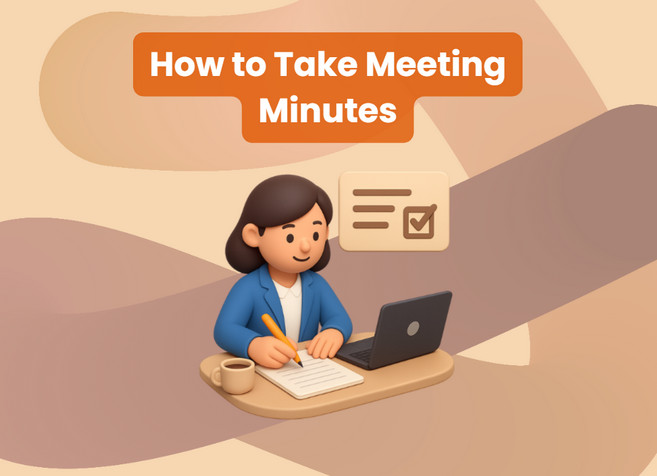





Leave a Comment